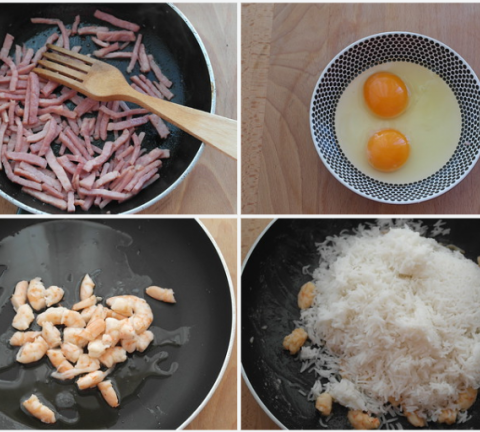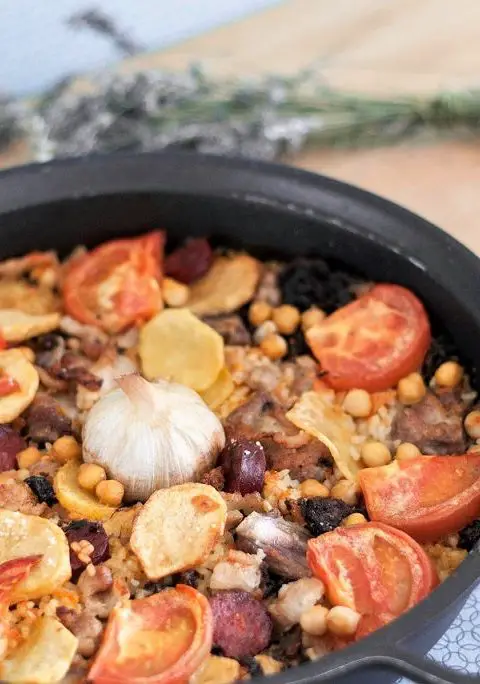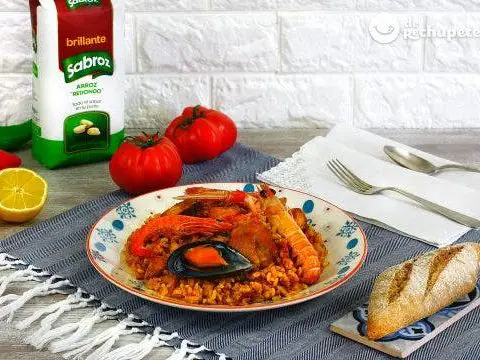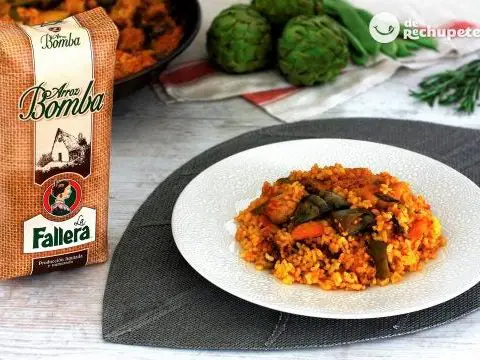
Info.
- Half
- 60 minutes
- For 6 people
- 3.5 € / person
- 245kcal per 100g.
How to prepare a banda rice .
A traditional rice recipe that triumphs throughout the Levante.
Until recently I did not dare with this type of recipes, since they are rice that must be caught. Also know very well what ingredients to use and respect the tradition of it.
These are several of the premises that the friends of Wikipaella are looking for, which have encouraged me to prepare and publish the best rice dishes in their community.
Like paella, these types of recipes work best when you enjoy them with friends or family, beer in hand and good chat.
The banda rice has a very humble origin, the fishermen prepared it with the leftover fish.
A kind of ranch that was served on the boat and eaten on deck. It consisted of 2 deliveries, one with the discards of cooked fish when making the broth, seasoned with all i oli or salmorreta . And then the separate rice (a banda, in Valencian) that was boiled with the fish stock in a cauldron.
The rice recipes to banda that we can find in the Valencian Community are many. But I assure you that they no longer have anything to do with what was prepared in the past, it was more a broth rice than a paella . For this rice we have trusted the La Fallera pump rice that gives us such a good result.
Although the current one is impressive, full of sea flavor and I assure you (I have eaten a few) in each region, it is more in each town, they have their own recipe. It happens with most traditional recipes, with a base, in each house it is usually prepared in one way.
On the blog you will find other recipes with rice, from baked rice , seafood fideuá , black rice , rice with chicken and rabbit to or broth rice .
Every year we spend the summer in Dènia , there is undoubtedly where I have eaten the best rice dishes.
For them it is a sophisticated and very well prepared dish, an art, and that’s where they taught me how to prepare it, as I present it here, without onion, garlic, ñoras, or many ingredients. So I encourage you to prepare it and let me know if you like this type of rice.
Preparation of the broth or fumet for the rice
We will always start with the fish stock or fumet and then the rest of the rice will go.
- We peel the prawns, remove the head and the shell that protects them.
- We start with the head that is the most flavorful, making a simple rotation we easily detach it. We reserve them to fry or cook and thus get a good seafood fumet or broth.
- Then, from the bottom of the belly, where the legs are. We remove with the hands the different rings or shell that cover the body along with the legs.
- We put a casserole with a good jet of olive oil and fry the shells and heads. Remove from the heat and add a teaspoon of paprika. Mix well and add the water, about 2 liters approximately.
- We let it be done for about 15 minutes. If we have monkfish bones or other fish, we incorporate them.
- We can even crush everything with a Chinese or pressing in the strainer to get more flavor. We strain everything well and keep it warm for the rice.
- Once the prawns are peeled we must remove the intestine (a black thread that they have inside) that we must remove. We reserve.
Final preparation of the banda rice
- In a paella pan, add extra virgin olive oil and add the cuttlefish (previously cut into cubes).
- Brown over medium heat, then add the prawns or prawns (which we have reserved) in cubes. We fry well so that the flavors come together.
- As soon as they are colored, add the grated, skinless tomato to the banda rice.
- Fry with the rest of the ingredients, this process takes about 5 minutes over medium heat, always stirring constantly. At this point it already smells so good that you would eat it without rice.
- We introduce the rice and we combine everything gently so that it is well impregnated with the stew and absorbs the flavor, stirring until the rice is pearly.
- Leave for 5 more minutes on medium heat. For the bomb rice issue, the exact measurements are 2 and a half parts of water for every 1 rice.
- We add the saffron (previously toasted) and the sweet paprika, frying gently, avoiding burning, otherwise it may become bitter.
Presentation and socarrat of rice a banda
- Once the rice has absorbed all the flavor of the ingredients, add the fumet to the paella.
- In this case there are 600 g of rice with which we will have to add 1 liter and a half of water.
- We raise the temperature to the maximum until it begins to boil. Then we lower it in half and let it be done little by little, this process lasts between 15-20 minutes.
- It all depends on the fire, they are usually 15 minutes for broth rice and 18 for dry rice.
- Halfway through cooking we taste the broth and rectify with salt. After fifteen minutes the liquid must have been consumed and the rice must still be a little hard. It is when the famous socarrat begins to form.
- Remove from the heat and let stand 5 minutes covered with clean cloths.
- The rice will finish making and the socarrat will be completed out of the fire. And that’s it, serve it freshly and generously.
You can see all the photos of the step by step of this recipe for rice to band.
Tips for a rice to yummy band
- To prepare a good rice to band we do not need a rush, so I recommend it as a weekend rice.
- To remove the intestines from the prawns, we help ourselves with a toothpick or with the tip of a knife. With the toothpick we prick the end of the intestine that is visible and pull it. It should come out whole, as if it were a thread, without opening the shrimp, so that it does not lose juice and flavors during the preparation. It is thrown because it tastes bitter and can bring sand or the last thing the prawn ate.
- You can make the fumet with a lot of rock fish, galleys, the heads and shells of prawns or shrimp and some vegetables.
- The arroz a banda is a very tasty fish rice, perhaps the most I like. Traditionally it is usually served with a good all i oli or aioli (ajoaceite) .
- And being strict with tradition, also with the fish with which it has been prepared “a banda”, which in Valencian means separately or aside.
- Once the rice has been spread over the paella, it should be removed as little as possible. Otherwise it will release its starch and in the end the grain will not be loose.






